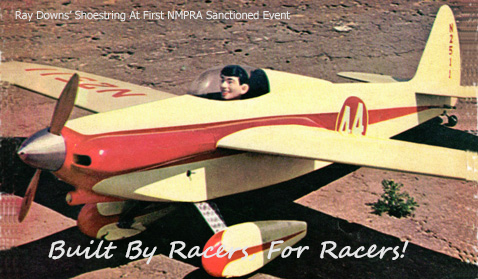

 |
 |
|
|
The urge to race dates back to early civilization with foot and chariot races held during Greek and Roman periods. The risk, excitement and challenge of racing are basic to human nature. Presently, we enjoy races involving boats, automobiles, horses and even turtles. Races involving aircraft began shortly after the advent of powered flight and soon started in the field of model aviation - first with rubber-powered free-flight planes and later with control line team and rat race events. The ability to precisely control a model in three dimensions provided the Impetus of R/C Pylon Racing, as we know it today. In fact, the first suggestion of R/C Pylon Racing was made at the 1948 Nationals at Olathe, Kansas. The initial rules were presented to AMA R/C Committee in 1956. The first AMA Pylon event was flown in 1957 and won by Howard Bonner with a semi-scale Bonzo. Two years later a finalized version of rules was adopted by the AMA, and R/C pylon racing was born! Early pylon racing was flown around a two-pylon course with the pilot standing in the middle. The winner was determined by the plane posting the shortest elapsed time; which would be calculated to the highest speed. There were no aircraft design specifications and the low drag flying wing or delta models dominated the event. In the mid-sixties there was a strong feeling to race scale type aircraft simultaneously over a triangular shaped course similar to full size Goodyear Model Racers flown in the late forties. Originally flown as an Exhibition Event under the direction of the NMPRA at the 1965 and 1966 Nationals, the "Goodyear" model event became Official at the 1967 Nats in Los Angeles. It soon became very popular and current R/C Pylon Racing has developed into three classes or events that are separated by aircraft requirements, engine specifications, and fuel restrictions and course length. The three AMA R/C Pylon Racing events are Quarter Midget, Quickie 500 and 1/2-A with the Specific rules for each printed in the AMA Official Model Aircraft Regulation book.
Quickie 500 is a popular variation of Sport Pylon and has largely replaced this event. Quarter Midget retains the scale-like aircraft requirement. The National Miniature Pylon Racing Association (NMPRA) was formed in 1965 as the governing body for model pylon racing in the United States. The NMPRA worked with the Academy Of Model Aeronautics in formulating rules and regulations for the flying of miniature pylon racers. The following table lists those who have served as NMPRA Presidents.
National Miniature Pylon Racing Association Presidents
* 2003 Interim President Bob Brogdon * 2005 Interim President Bob Brogdon * 2011 Interim President Dan Kane Jr. The following article from the June 1965 issue of Radio Control Modeler magazine is a report on the first NMPRA sanctioned race held in Turlock, CA.
The following article by Dan Kane discusses how composite wing pylon racers got their start. Two individuals lead the charge and developed the first fully molded pylon racers, Jerry Small with his Shoestring and Gary Hover with his Kaze F1.
The following article documents both of their efforts in producing the first molded pylon racers. I would be remiss if not to mention Bob Smith in this context as well.
The second passage was written by Gary Hover: For me (Gary Hover), it started when Jimmy Shinohara and I were building Stilettos in 1989 for Dave and me to fly in the World Championships. We were very careful to build them
exactly the same, and yet they all flew slightly differently. While at the world championships in Virginia Beach in 1989, I felt there must to be a way to make a strong, lightweight molded wing.
When I was taught the process of making wings, I was told that I was only the 4th to know the process and had to swear to keep the information to myself. As time passed, this process is used by many and is the standard for producing hollow molded wings in all disciplines of RC. Hopefully, you can appreciate the time and effort that was put forth by both of these revolutionary modelers and how they have impacted and transformed pylon racing as we know it today.
In 1973 the NMPRA published the NMPRA Pylon Racing Book in an effort to promote pylon racing. It provides information on the history and current state of pylon racing at that time. Click Here To Download The Book |
||||||||||||||||||||||||||||||||||||||||||||||||||||||||||||||||||||||||||||||||||||||||||||||||||||||||||||||||||||||||||||||||
 |